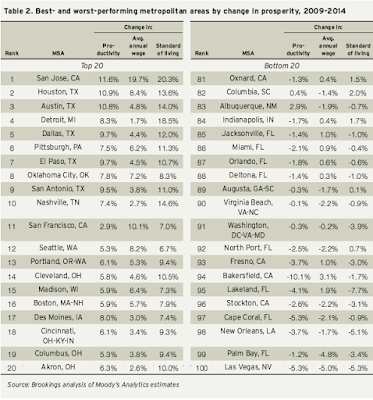By Stephanie Allen, Project Assistant
For decades,
economic development was traditionally concerned with creating jobs, and that
perspective still influences some of the key decisions being made. What the new
jobs pay and what sort of lifestyle they afford has not often been a big topic
of discussion. We sometimes see communities that tie incentives to the
number of “high paying” jobs created, but what we haven’t seen much of are
communities concerned with creating jobs that pay a living wage for all. For a
long time, economic developers have taken the approach that a rising tide lifts
all boats.
But according to Brookings
this hasn’t been the case in the recovery from the Great Recession: “growth in
metro economies [from 2009 to 2014] did not reliably improve all residents’
economic fortunes.”
The further stratification of the lower and upper classes
and the disappearance of the middle class in the wake of the Great Recession
have more than a few economic developers rethinking their approach.
Enter inclusive economic development.
Inclusive economic development aims to lift all boats—to
create an economic system that builds wealth and prosperity for everyone. This will require shifting
our focus from looking solely at indicators measuring growth and prosperity, to
considering how that growth and prosperity is distributed among the community.
The new report from Brookings’ MetroMonitor suggests that looking at indicators such as the change in median
wages, the change in the relative income poverty rate, and the change in the
employment rate can give us a better picture of how an entire community is
faring economically. And, we can see from the tables below, that the communities
with high rankings for growth and prosperity are not necessarily the ones that
rank highly on measures of inclusion.
Raising all boats isn’t just about attracting high-paying
jobs. So, how do we create wealth and prosperity for everyone?
The CitiesBuilding Community Wealth report from the Democracy Collaborative suggests
we need to create a new system, a new framework for inclusive economic development—one where concern for broad
prosperity and the whole community is at the core. The report suggests a new framework,
which they call Community Wealth Building. The following chart compares this
new framework to the traditional one.
As you can see, inclusive economic development looks very
different from the traditional approach. In the midst of a very slow recovery
from the Great Recession and the dawning realization that the post-recession
economy is a very different one, proponents of inclusive economic development
ask us to think about why we engage in economic development at all. Presumably,
what we want is to lift all boats.
Some economic developers (e.g., CenterState Corporation for Economic Opportunity) are realizing that's our best shot at long-term economic stability. Traditional approaches, it seems, are lifting some boats but leaving others to run aground. So, if what we really want is to build long-term wealth and prosperity for our communities, it’s time to reevaluate our strategy.
Some economic developers (e.g., CenterState Corporation for Economic Opportunity) are realizing that's our best shot at long-term economic stability. Traditional approaches, it seems, are lifting some boats but leaving others to run aground. So, if what we really want is to build long-term wealth and prosperity for our communities, it’s time to reevaluate our strategy.





